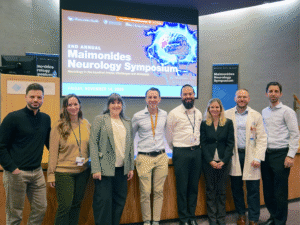Dr. Jeffrey Basti discusses the benefits of having a primary doctor at every age and the importance of preventive medicine and annual check-ups.
Listen on Spotify, Apple Podcasts, or iHeartRadio.
Prakash Chandran: There seems to be a trend for the younger generation to access healthcare on an as needed basis. And in fact, one study showed that 45% of young adults didn’t have a primary care physician. And instead of proactively going to see one, many prefer to just visit an urgent care when something arises.
Here to tell us more about the benefits and role of a primary care physician is Dr. Jeffrey Basti, Director of Primary Care Medicine and Vice Chair of Medicine at Maimonides Medical Center.
This is Maimo MedTalk. I’m your host, Prakash Chandran. So Dr. Basti, thank you so much for joining us here today. I’d love to get started by you telling us a little bit more about the role of a primary care physician and why it’s important to have one.
Dr. Jeffrey Basti: That’s a great question. So primary care seems to be the best entry for patients to get into seeing a physician. You know, a small clinic, CityMD, they’re good for a quick fix. But to get to know a doctor and the patient doctor relationship really grows when you get a patient who comes in to see you. So they get to know the patient, they get to know all about the patient, the family, social matters. So you get the whole picture.
When you go to somewhere like a CityMD and I’m not taking anything away from them because they do have a certain place here. They don’t get the whole picture. They get a snapshot of, “I have a sore throat” or “I have belly ache.” But the primary care not only gets the belly ache, he also gets to know about somebody in the family who may be having issues, who’s got an alcoholic problem, who’s got social issues with not being able to make certain rent money. I mean, there’s a million things that we hear every day that we cannot always help, but can direct people to the right things. So it’s more than just a physician-patient relation. You really get to know the patient and the patient really gets to know you and trust you. And that’s probably one of the biggest things that the primary care physician can do besides good medicine and that’s something we can talk about.
“You really get to know the patient and the patient really gets to know you and trust you. And that’s probably one of the biggest things that the primary care physician can do besides good medicine…”
Prakash Chandran: Yeah, that totally makes sense. And also, you know, we’re just kind of multifaceted human beings and there’s so many things that roll up into the way that we feel. There might be external factors that are affecting a person’s outcome. And when you see someone over time, that person has a more holistic view of a patient. Wouldn’t you say that’s correct?
Dr. Jeffrey Basti: That is absolutely correct. And that’s called trust and that’s the big thing that we need in society lately besides being in a patient-doctor relationship.
Prakash Chandran: Yeah. And a young adult who sees a primary care physician, how often do they visit?
Dr. Jeffrey Basti: So it depends if the age groups that you’re saying, they can come in once a year, you know, as a younger adult in their early, late teens, early twenties for a general physical exam. We see other areas of problems in the younger years that tend to fall off later on. And then, as we get to the middle-aged, you know they just decreased the age for screening for colon cancer to 45. They did do it a couple of years ago, but people, they think it’s still 50. They moved it down to 45.
And there’s other ways to do it besides colonoscopy. We actually also do lung cancer screening now, which we have been doing for years and they actually moved that age grouping down to 50 years old. So there’s a lot of things that primary care can lead and do preventive medicine and that’s really an important thing that we can help the patient with.
Prakash Chandran: You know, there’s going to be young adults that might be listening to this, who just don’t think that they need a primary care physician. You know, maybe they feel like they’re very healthy. And when something arises, that the urgent care is an acceptable substitute for them. What might you say to them?
Dr. Jeffrey Basti: Well, the primary care doctor will be there for a longer period of time. There’s sort of a pact between the both of you, if not for a better word, that, you know, when you need help, you know, I or the other doc or a doctor would be available who knows you, so the patient may be seeing different doctors all the time. We try not to do that. We try to see the same doctor or, if you can’t see him for that emergency visit, the next time you will see them or there can be a conversation between the doc, the primary doc, and maybe an associate who saw the patient that day on a telephone basis because we know how to get in touch with each other pretty quickly. So that’s one of the good things that the primary care doc can offer patients, even younger patients who come in with different things as a young adult. We still see appendicitis, we see testicular carcinoma and we see things in younger patients that need to be looked at and, you know, just be aware of.
Teaching patients, young adults what to look for, explaining examinations, explaining to young males about testicular exam, which males usually don’t see GYNs, but the GYN usually teach breast exam to the females. So the young male adults really is not being taken care of and not being shown what to do to protect themselves from different disease entities.
Prakash Chandran: Yeah. And a lot of these proactive measures that you are talking about just isn’t something that is handled at the urgent care, right? Urgent care is a lot more responsive or reactive to things that people come in with. So all of this education that you’re discussing is not really the role of an urgent care. It’s a role of a primary care physician to do that. Is that correct?
Dr. Jeffrey Basti: That is absolutely correct. They are just there to meet the problem that is confronting them and address it and treat. And then they usually go say, “See your doctor in a week” or “You call them in the morning and let them know what happened here,” and that’s where that leads. It’s not a formal long-standing relationship.
Prakash Chandran: Right. And I’m trying to separate out for the young adults that might be listening, when is it appropriate to go to an urgent care versus going to a primary care physician?
Dr. Jeffrey Basti: So the first meeting should not be under duress. It should be a scheduled meeting where you and the doctor or the patient and the doctor can speak together, get to know each other a little better so they can understand if there’s a problem with the patient and then they can order testing that may need to be done.
And then, there is time to discuss those tests with the adult or the adolescent and make a formal plan. You know, there’s young people with high cholesterol. There’s young people with blood pressure or thyroid disease. There’s a myriad of diseases that we find that people didn’t even realize they had.
So that’s why it’s good to get that once a year exam or, you know, it depends on how often they need if there’s an issue, maybe every six months. So yes, this is what we call preventive medicine. I also did ICU and critical care medicine and I saw the other end of the scope where people miss the preventive medicine part, and now they are stuck in an ICU. So if we get it quickly and we’re in front of that curve, we do better. And that’s really important.
Prakash Chandran: Right. And so, you break a leg or you cut yourself, you go to an urgent care. But if you want to do more of that preventative care, something more proactive, that’s when you’re building that relationship with a primary care physician. They’re really responsible for helping you with that education and looking further ahead in your medical care. Is that correct?
Dr. Jeffrey Basti: That is correct.
Prakash Chandran: So let’s talk a little bit about the value of annual checkups specifically for people in their 20s compared to people in their 30s, and then people in their 40s.
Dr. Jeffrey Basti: So annual checkups are good to monitor the blood pressure, to monitor the cholesterol levels, to make sure that there is underlying disease that’s starting to show that the patient is ignoring, which we see a lot. Especially in young adults, they push everything to the back burner.
So like I said, proactivity is very important in a lot of disease entities that we’d like to head-on first, instead of becoming where it’s kind of laid down the road. And not only that, when there is an issue that the patient is having, we can usually tell whether it’s serious. You know, when somebody comes in with a little lump or something, you know, we can either say, “Listen. Calm down. It’s not that we’ll treat this. And then if it doesn’t get better, then we’ll do the next step. But for now, it doesn’t look like an issue, and let’s get treatment underway.” And then, you know, you can either bring them back and see what’s going on from there on. So it’s also the relationship of a calming factor for patients that get anxious when there’s an issue that they don’t understand. So we understand the issue and we can address it and treat it. And if we need further testing, we will go down that road or it gets better and everybody’s good to go.
Prakash Chandran: Yeah. And I also imagine in addition to that at these different age groups like 20s and 30s and 40s, you have a template or you have a series of things that you might test and look out for proactively just to make sure everything is good. So like you take your car in and they do the, you know, 20,000-mile checkup, 30,000, 50,000, 100,000-mile checkup, you have similar things that you would do for people in these age groups. Is that correct?
Dr. Jeffrey Basti: That is correct. So, usually things in the early 20s are pretty much stable, unless like I had mentioned before, there’s other changes. When we start getting up to the 30s and 40s, that’s when we can see issues starting especially if there’s family history, we like to take good family histories or people are smoking or people are drinking or people have a drug issue or a medication issue, a prescription drug medication. And we can see these things and address them so that we can stop a potential disaster.
Prakash Chandran: And I wanted to narrow in on women in their 20s and 30s. My wife, for example, is 32, and I know that she sees an OB-GYN once a year. But I actually can’t remember the last time she saw her primary care physician. So is there a need for women in that age group to see both a primary care physician and an OB-GYN?
Dr. Jeffrey Basti: Well, it depends on how the scope of the OB GYN is. You know, some want to be involved in everything and some do not want to be. So most of the time, they will say see your primary care if you have asthma or if you have thyroid disease. The OB-GYN would usually defer to the primary care doc to take care of that.
So, it’s always good to have two eyes looking at one person. It’s better to find an issue and start treating it or, you know, OB-GYNs are not always available like primaries to see patients. And so, better to have somebody that could see you for something else besides a GYN problem or an OB problem.
Prakash Chandran: Okay. That’s helpful. And just moving back to these different age groups, what about for people in their 40s and 50s? What is the value that they get out of seeing a primary care physician at that age?
Dr. Jeffrey Basti: Those patients, like I said, we start our screenings for colon cancer, breast cancer and, again, hypertension, cholesterol, lung cancer screening on people who smoked many years and we also do smoking cessation for them. So there’s a lot of things the primaries can offer besides vaccinations. People need to be vaccinated at certain intervals. And, you know, physicals for a job, we do all this kind of work with patients. So there’s a lot of things about a primary care that keeps records of the patients vaccines or blood work that we know that they got vaccinated. So there’s a lot of good things that primary care can do for all the patients.
We know that life expectancy has gone down because of primary care docs are not as available or they’re not being seen like they used to be. So there’s going to be some type of change where we need more primary docs and, you know, that is something that the medical field is looking at. Why in other areas or other countries or people that do go to primary docs have better life expectancy than the ones who don’t? So there was just an article in the New England Medical Journal in September about this whole problem. And even the vaccines, if we had a really firm primary care system, it could have been given out that way with the COVID-19 vaccines. So, it’s vital that people get involved with a primary. There’s a lot of good things to it. I don’t see any downside.
Prakash Chandran: Well, Dr. Basti, I really appreciate your time today. Is there anything else that you’d like to leave our audience with?
Dr. Jeffrey Basti: I wish you all good health. Make sure you see your docs and get your screenings and your vaccines. It’s important. It will enhance your life. It will protect your families. It does a lot. So, go out and see your doc and a be safe.
Prakash Chandran: Perfect place to end. Thank you so much for your time, Dr. Basti. And thank you all for listening. You can visit my maimo.org. That is M-A-I-M-O dot org to schedule an appointment with one of our primary care physicians and to check out all of our other podcasts for more topics that might interest you. This has been my Maimo MedTalk. I’m your host, Prakash Chandran. Stay well.







